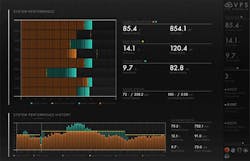Virtual Power Systems (VPS),has secured $17 million in Series B Financing to fund the development of “software-defined power” for data centers. The funding round was led by power equipment vendor CUI Global with participation from a group of existing investors.
Virtual Power Systems is a startup based in Milpitas, Calif that offers software, hardware appliances and lithium-ion batteries to optimize power distribution within a data center. VPS said the money will allow it to accelerate R&D and marketing efforts, and advance adoption of its technology.
“This latest financing reinforces investor confidence in our ability to set new standards in power infrastructure efficiency and economics,” said Steve Houck, CEO of Virtual Power Systems. “As the SDP category leader, we are driving rapid market adoption through a robust ecosystem of power infrastructure hardware partners while transforming data center power management and utilization, enabling the next generation of Software Defined Data Centers.”
CUI Inc. launched the first commercial product based on VPS technology in March 2018, when it began selling a UL-certified ICE Block lithium-ion battery appliance. This week’s funding represents a vote of confidence for the technology.
“VPS and CUI share the vision that the convergence of data center power infrastructure and software will dramatically improve how energy is provisioned, managed and utilized in modern data centers,” said William Clough, president, and CEO of CUI Global. “Together, we’ve set an aggressive pace for advancing the technology and expediting the availability of Software Defined Power technology.”
How Software-Defined Power Works
Software-defined power is similar in concept to the role lithium-ion batteries play in a hybrid car, providing energy as needed, and then charging when not in use. Data center batteries and IT resources are managed by a software suite created by Virtual Power Systems. This approach effectively creates pools of power that can be applied to IT assets in a granular fashion.
As with server virtualization, software-defined power offers the promise of bringing new levels of efficiency and automation to data centers. That includes reallocating power from underused racks to IT gear that requires additional power.
How does it work? Virtual Power Systems uses a combination of software and distributed batteries to conduct peak shaving, using the batteries to store power and allocate it to the system when more is needed, creating a more elastic system for distributing power across resources. The batteries and power flows are managed by the company’s ICE (Intelligent Control of Energy) software suite, which allocates power from by utility sources, UPS systems and batteries.
ICE software connects with power and IT systems over Ethernet, collects power use data at server, rack, row and data center level, and intelligently controls power distribution in and to racks.
In addition to its work with CUI, VPS is collaborating with Artesyn Embedded Technologies, Schneider Electric, CE+T and VMware.
“SDP addresses one of the biggest challenges facing data centers today,” said Jennifer Cooke, Research Director, Cloud to Edge Datacenter Trends and Strategies, at IDC. “We have witnessed how software defined and hyperconverged solutions from companies, such as VMware, Microsoft and Nutanix, have dramatically improved data center operational efficiency across compute, network and storage. VPS is pioneering a similar approach by virtualizing data center power infrastructure using machine learning and AI.”






